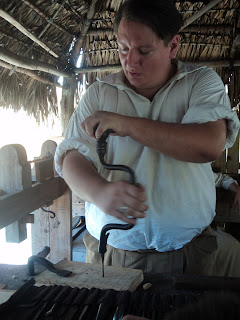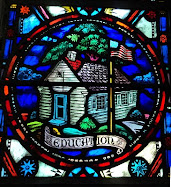Here are suggestions for four family Advent nights.
To make it easier for young children to understand, you may wish to choose a simplified Bible version such as the NIrV. Your children can take turns reading the Scripture verses for each evening. If your child struggles with reading, assign just a verse or two, and have them practice it ahead of time.
It may also help to provide song sheets for when you sing the Christmas carols. You can download lyrics from the web (I have provided the links) and print them out. You can even talk about the historical backgrounds of some of the carols.
These ideas are just suggestions. You can choose whatever Scriptures, songs and activities fit your family. I found it helpful to weave in things we already wanted to do, such as drive around to see Christmas lights.
When we did this in 2005, our four nights were crammed into a one week period. I took a bright yellow piece of paper and divided it into several blocks, one for each day until Christmas. Then, in bold letters, I wrote out a brief description of what we had planned for each evening, including the four family nights and other planned events, such as a child’s basketball game or the Christmas Eve service at church. Last year, we spread it out, doing an Advent night once a week for four weeks.
~*~*~*~*~
Family Advent Night #1
“God is With Us – Prepare Your Heart!”
Tell your children ahead of time that you will be having a special time in the evening. Talk about a few of the things that you will do together. If you can think of a way for your child to participate, ask him to prepare for this, such as practicing Bible verses to read out loud, or a song on the piano, etc. Another child might make copies of a song sheet. You will talk about this advance notice and preparation a little later.
Scripture
Isaiah 7:10-14 – Immanuel promised
Isaiah 9:2, 6-7 -- darkness and light, a child shall be born, Wonderful Counselor
Isaiah 53:10-12 -- the suffering Savior
Isaiah 61:1-3 – the ministry of the Messiah
Matthew 1:18-25 – Immanuel comes
Discussion: Immanuel means “God with us” and Jesus means “The Lord saves.” Why do we need a Savior? Because we are sinners! Remind your children that you told them ahead of time some of what you would be doing, so they could know what to expect and how to prepare. Relate this to how God took the time to tell his people, through the prophet Isaiah, several hundred years early, that a special messiah would be born. He told them many details so they could know what to expect.
Songs
“O Come, O Come Immanuel” – The lyrics of this song (originally written in Latin) are a prayer for the Messiah to come and set the people free from their misery in sin. The tune was written in a minor key, which makes it sound melancholy to fit the lyrics. You may wish to point this out to your older children. What makes it a minor key? If you play a C major chord, it will be the notes C, E and G. If you play a C minor chord, you will use C, E flat and G. If you sing this TO your children, have them join in on the chorus after each verse. http://www.cyberhymnal.org/htm/o/c/ocomocom.htm
Handel’s Messiah – play a selection such as “For Unto Us a Child is Born” (which is from Isaiah 9) and tell your children how George Frederic Handel wrote a whole concert using verses from Isaiah that prophesied about the Messiah.
Activity
Drive around through different neighborhoods to look at Christmas lights. Remind your children that Jesus came to light up the dark world. We should be lights in the world, too, if we have Jesus in us.
~*~*~*~*~
Family Advent Night #2
“Jesus is Our Glorious King!”
Scripture
Luke 1:26-56 -- The angel told Mary that she would give birth to a king. When she visits her relative Elizabeth, she speaks forth what is now called the “Magnificat” – a psalm of praise to God. When you read the Scriptures this evening, choose people to read the parts of the narrator, Mary, the angel and Elizabeth. Practice ahead of time, if possible.
Discussion: Ask what good things we can say about God and what he has done for us.
Songs
Choose other favorite Christmas carols.
Activity
Watch the movie The Lion, the Witch and the Wardrobe, which you can rent or buy on DVD. Talk about it and how Aslan represents Jesus as the King who came to redeem his people.
You can also have each family member write a psalm of praise to God.
Allow one of your children to perform a song he or she has learned to sing or play on an instrument, or read a poem. This will be good practice for tomorrow night, if you choose to visit other people.
Family Advent Night #3
“Angels Sing!”
Scripture
Luke 2:1-21 – the birth of Jesus
Colossians 1:15-20 – the deity of Jesus (optional)
Discussion: Who was Caesar August? What is the census? Talk about how many people would have to travel to Bethlehem for the census, and that’s why there wasn’t any room in the inn. Shepherds were some of the lowliest and least respected members of society, but God chose them to be the first visitors to the newborn King. Perhaps that is because Jesus is our Good Shepherd, who lays his life down for his sheep!
Songs
“Silent Night” http://www.cyberhymnal.org/htm/s/i/silntnit.htm
Activity
Go Christmas caroling! You can walk around your own neighborhood, drop in on special friends or relatives, or visit a nursing home. If you do visit a nursing home, check ahead with the administrators to make sure this is OK, since there may be other groups visiting or the residents might go to sleep really early in a particular facility.
If you plan to stay home, choose another activity, such as:
- Read your favorite books about the first Christmas.
- Act out the Christmas story.
- Draw pictures of the Nativity scene.
- Make a simple nativity scene with felt or clay.
*~*~*~*~
Family Advent Night #4
“Wise Men Still Seek Him”
Scripture
Luke 2:22-40 – Simeon and Anna were very old, but they had been waiting many years for the Messiah to come. They were wise enough to recognize baby Jesus as the one God had promised through the Scriptures – and to praise God for it! The Holy Spirit even told Simeon to go to the temple courtyard that day!
Matthew 2:1-12 – The Wise Men had come from a long distance to see the newborn King. God can even use a special star to guide someone to Jesus! Compare their response to Jesus to the jealous reaction of King Herod. You can also talk about the meaning of the gifts the wise men brought. If you sing all of the verses of “We Three Kings” (as listed on the Cyberhymnal site linked below) they tell us that gold is for a king, frankincense was used for prayer and worship, and myrrh was a burial spice reminding us that the Messiah would die for our sins.
Discussion: Are we led by the Scriptures and the Holy Spirit? Do we love to spend time at the Lord’s house like Simeon and Anna did? Are we willing to go anywhere for Jesus, even if it is a long way from home? What gifts can we give to God?
Songs
“We Three Kings” -- we don’t know how many wise men there were, and the Bible doesn’t say they were kings, but the song is good anyway! In this song, orient means the eastern region of Asia. That’s why we say people from China, Japan, Korea and other countries in that area are oriental. Maybe you could eat oriental food for dinner tonight!
Activity
Decorate Christmas cookies which you have baked ahead of time. Deliver some of them as a gift to someone who might need a lift in their spirits – because what you do for other people in his name, you do unto Jesus. Or, if you want to be really ambitious, choose a needy family and buy presents for them. Enclose an encouraging note with Scripture, and deliver the bundle secretly to their doorstep.
~*~*~*~
The Wexford Carol
12th Century Irish
Good people all, this Christmas-time,
Consider well and bear in mind
What our good God for us has done
In sending his beloved Son.
With humble hearts we all should pray
To God with love this Christmas day;
In Bethlehem upon that morn
There was a blessed Messiah born.
With thankful heart and joyful mind,
The shepherds went the babe to find,
And as God's angels had foretold,
They did our saviour Christ behold.
With humble hearts we all should pray
To God with love this Christmas day;
In Bethlehem upon that morn
There was a blessed Messiah born.






























































